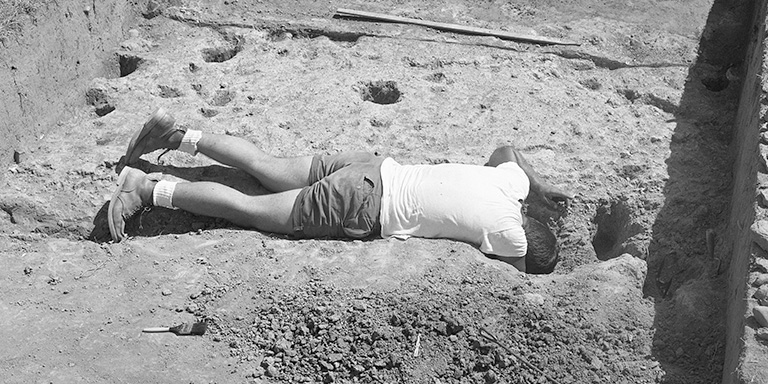Glenn A. Black (1900-1964) was Indiana's first professional archaeologist. He dedicated his adult life to the study of archaeology and focused much of his attention on learning about the people who inhabited Angel Mounds. His personal artifact collections, archaeological library, personal and professional archives, and long history of archaeological record-keeping (documents and images) are housed at the IUMAA. Read further down the page for a more complete biography of his work.
The Glenn A. Black Collections
Collection Highlights
Artifacts and Documentation
The IUMAA Archaeological Collections house approximately 2,000 objects from Glenn A. Black's personal archaeological collections. These artifacts consist of axes, celts, pestles, hammerstones, scrapers, drills, points, and more. In addition to the objects, all of the archaeological documentation related to excavations he conducted are available alongside the artifacts.
Image Collections
The Archaeology Historic Image Collection is largely comprised of photographic prints, negatives, slides, and film reels that document the excavations and work of Glenn A. Black.
Black's images
Many of the images have been digitized and are available online!



1954 all female field school (N2383); Students photographing artifacts, 1950 (N1788); Student cleaning out post hole, 1960 (N4981)
Library and Archive
The IUMAA Reading Room contains Glenn Black's personal and professional correspondence, drafts of articles, and administrative records for the Works Progress Administration project at Angel Mounds. The extensive library of books collected and gifted to Glenn Black while residing at Angel Mounds are also at the IUMAA.
Glenn Black and Indiana Archaeology
His Start
Glenn Albert Black was born in Indianapolis on August 18, 1900. He graduated from Indianapolis Technical High School in 1916 and served as an estimating engineer for Fairbanks-Morse Company through the 1920s. In 1931 he declined moving to Wisconsin with the Company in "view of his family responsibilities" and found himself without a job. Throughout his twenties though, Black had been studying archaeology and collecting artifacts as a hobby. As part of his attempts to better understand the cultural significance of these artifacts, he copied out by hand every published reference to Indiana archaeology available at the time.

The Indiana Historical Society

In 1931 the Archaeology Section of the Indiana Historical Society, which included Eli Lilly, invited Warren K. Moorehead to speak to the Society and inspect a number of archaeological sites in Indiana. Suddenly in need of a person to be part driver-part guide, Lilly reached out to the young and knowledgeable Glenn Black. The archaeology road trip took place the first two weeks of May 1931 where Moorehead claimed that Angel Mounds was "a most important place archaeologically" in Indiana and Glenn Black "an intelligent and willing worker" who would "make good" in the field of archaeology.
Glenn Black was appointed the Indiana Historical Society Archaeologist in June 1931. His first assignment that summer was to survey Greene County, Indiana and excavate a number of sites. From October 1931 to May 1932 Black apprenticed at the Ohio State Museum under Henry C. Shetrone. Upon coming back to Indiana he continued surveying and identifying important locations throughout the state.
Glenn Black was employed by the Indiana Historical Society for the next thirty-two years through contributions from Eli Lilly.
Angel Mounds
In 1938 the Indiana Historical Society purchased the land known as Angel Mounds and received Works Progress Administration (WPA) funding which permitted the "employment of needy persons on archaeological research in Indiana." Official work began April 27, 1939. Over the next 37 months the WPA Project at Angel Mounds hired over 200 laborers and uncovered over 2 million archaeological artifacts, many feet of documentation, and hundreds of images. America's entry into World War II ended the WPA project funding, though Glenn Black and his wife Ida continued to live on-site and act as stewards of Angel Mounds.
IUMAA Angel Mounds Collections
Over 2.5 million artifacts, 75+ years of images, thousands of documents...
Explore the Angel Mounds Collections
Angel on Exhibition
We're planning an exhibit about Angel Mounds in collaboration with Native partners. Check it out!
Indiana University
Indiana University (IU) added archaeology to its curriculum in 1944 and Glenn Black was employed as a Lecturer in the Department of Zoology and later the Department of Anthropology. In 1945, IU and the Indiana Historical Society cooperated to establish summer archaeological field schools at Angel Mounds with Black in charge. Black continued as a Lecturer, driving from his home near Evansville to the Bloomington campus every week, until 1960. He was Director of the Field School until his unexpected death in 1964.
The Glenn A. Black Laboratory of Archaeology (GBL) was built following Black's death and then dedicated in 1971 at Indiana University-Bloomington to house the various collections of Glenn Black and the archaeological collections of the Indiana Historical Society. The GBL worked to honor his memory by pursuing excellence in research and archaeological education. The work continues now as part of the IU Museum of Archaeology and Anthropology.
Resources
Edington, Will E. (1964). "Necrology: Glenn Albert Black." Proceedings of the Indiana Academy of Science, 74, 42-45. https://journals.iupui.edu/index.php/ias/issue/view/423
Kellar, J. H. (1966). Glenn A. Black, 1900-1964. American Antiquity, 31(3), 402–405. http://www.jstor.org/stable/2694742
Kellar, James H. (1967). Glenn A. Black. Indiana Magazine of History, 63(1), 49-52. http://www.jstor.org/stable/27789377
Ruegamer, Lana. A History of the Indiana Historical Society, 1830-1980. Indianapolis: The Society, 1980. [IUCAT]

